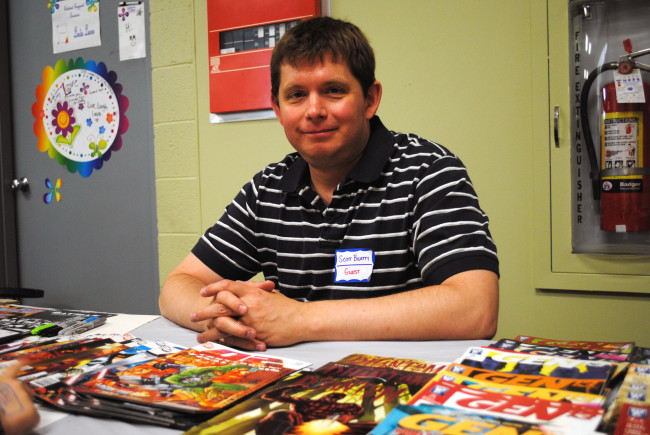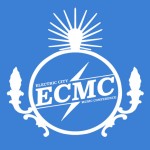ARCHIVES: From Batman to Scranton – writer Scott Beatty celebrates Free Comic Book Day at Comics on the Green

Not only is Comics on the Green in downtown Scranton offering free comics on Free Comic Book Day this Saturday, May 4, but the shop is also offering the chance to meet one of those comic’s writers.
Scott Beatty, known for penning characters like Batman, Robin, Green Lantern, Sherlock Holmes, The Shadow, The Phantom, and many more, will be stopping by his favorite comic store to sign autographs and talk to fans old and new celebrating this annual national event. The 43-year-old Lake Ariel resident chatted with NEPA Scene first about breaking into the industry, the “Batgirl” movie that almost was, and raising little nerds.
NEPA SCENE: Did you read comics from a young age, or did you discover them later?
SCOTT BEATTY: No, I’m definitely a “lifer” when it comes to comics. The “Super Friends” was my gateway in the early 1970s, just around the time my parents got their first color television; obviously, I’m dating myself. The fall of 1977 was when it really exploded for me. I suffered a bout of pneumonia and was hospitalized for a week. I missed seeing “Star Wars” on its first run through the local theater. To keep from going insane, my dad brought me comics from the hospital gift shop after I had exhausted the pediatric wing’s cache of “Highlights” magazine.
NS: What were some of your favorite comics then?
SB: I’m a “Johnny DC” from the start. I gravitated toward team books like “Superboy and the Legion of Super-Heroes,” “Justice League of America,” and “team-up” books like “The Brave and the Bold,” which featured Batman and a guest hero/heroine each month. After that, and thanks to DC’s awesome reprint digest collections, I explored every corner of the DC Universe. Ghost books, war books – it didn’t matter. If it had the DC bullet on the cover, I wanted to read it.
NS: Was there any particular comic that changed or shaped your perspective on comics?
SB: Alan Moore’s “Saga of the Swamp Thing” really helped me to see the literary potential of comics. Not too long ago, I wrote an essay for Comic Book Resources, an online site, in which I espouse about six stories that changed how I read and write comics. The mid-80s was a zeitgeist moment for comics, and not just for “Watchmen” and “Dark Knight Returns” or “American Splendor” and “Maus.” For me, some of the best and most inspiring superhero stores came out of the mainstream books at the time, tales which truly revealed the humanity behind these characters. These are touchstone stories for me.
NS: Did you always know that you wanted to write comics?
SB: I always loved comics. Superheroes are near and dear to me. I would have given my left kidney to write comics as a teen, but I never really considered it a potential calling until midway through graduate school. It was around that time that I decided to make attempts to “break in” and have a go at the comics biz. To make a long story short, as a creative writing major, I knew I wanted to write, but I didn’t want to be paying the bills by teaching and chipping away at a novel in what little free time was left after grading freshmen comp papers. Comics are episodic – you can see where I’m going – and I wanted to lay my hands on the characters that had filled my imagination since I first started to read.
NS: What was your first big break in the industry, and what was that job like?
SB: My first job in comics, technically, was as a copy editor for Wizard magazine. I was hired out of grad school with the foreknowledge that I’d eventually be taking on the task of helping Wizard Entertainment to launch Toyfare magazine. I assembled some of the staff that is more famously known now for heading to Hollywood and creating “Robot Chicken.” Working for Wizard enabled me to make contacts in both comics and toys, two industries that have made up the lion’s share of my freelance life for the last 15 years.
NS: How were you able to break into a big company like DC Comics?
SB: I broke in two ways. First, I got a reputation with friends like Mark Waid, who recommended me to DC editors when the “Secret Files” books were launched and they needed writers with good working knowledge of DC lore to write text pieces for what amounted to comic-sized primers for the various characters and books. My first script writing break came after doing Batman-specific pieces for editor Darren Vincenzo and the Bat Offices. Darren offered me a shot at writing a 12-page tale for “DC Universe Holiday Bash III.” Not long after that, Chuck Dixon pried the door open even further by inviting me to collaborate on the various “Year One” stories, which has led to a longstanding friendship and occasional partnership with Chuck in various creative endeavors.
NS: What is your writing process like, and is it different when you’re writing a book instead of a comic?
SB: Only the format is different. When I sit down to write, I write. It’s all about putting the words together. I surrender to the needs of the story. I have an office loft next to my children’s bedrooms, so I often listen to music on low. Or NPR. Or the news. I have lots of comics-related items around me, so I’m never too far from my primary muse. Books are more involved in terms of the demands of prose narrative. Comics have a shorthand, but it’s a language that leaves little room for failure. The words and pictures have to synch. I find myself talking aloud when writing dialogue, or the onomatopoeia of sound effects.
NS: Are you allowed a lot of creative freedom when working with established characters, or do the publishers limit what you can do?
SB: The basically philosophy is this: If it’s not my toy, I need to put it back on the shelf relatively unscathed. Batman sells toys and clothes and peanut butter. I’m not going to change Batman forevermore. My goal is to tell a good, fun, memorable story. I have to pitch my intentions from the outset. The publisher greenlights the basic outline. I do have freedom to be creative, but I can’t deviate too far from what I proposed. That’s the rule. If I’m struck by inspiration during the writing, it’s always best to consult with the editor and sell the idea if it’s truly worth exploring.
NS: Do you often collaborate with the artist while you’re writing the stories, or does that come after the story is completed?
SB: A little from Column A, a little from Column B. It all depends if I know the artist, or if I have contact info. I like to address the artist directly in scripts in order to help explain a particular nuance I’m aiming for or to call out a bit of reference I think would help in conveying the story. Again, comics are the marriage of words and pictures. I may start the ball rolling, but the artist has to be able to interpret what I’m saying. Ideally, we meet in the middle. I always encourage artists to call me if they have questions, but I still get excited to see my words turned into full color art. It’s magic.
NS: You’ve written many encyclopedias on comic characters. How do you go about researching so much information, and do you find that type of writing as enjoyable as writing stories?
SB: Most of the DC stuff came from memory. Before the Internet really became ubiquitous for fan sites and Wiki sources, I had to do much of it by actually reading every story. In limited cases, I can research online. But part of the fun has always been getting paid to read comics.
NS: Your “Year One” work for Robin, Nightwing, and Batgirl is among some of your most memorable work. Did you feel any pressure going back and creating origin stories for these iconic characters?
SB: No pressure at all. One of the caveats Chuck and I included in our pitches for our “Year One” trifecta was that we weren’t going to tread on pre-established continuity. All of our stories could slide right into the existing canon while broadening each of the origin tales for Robin, Batgirl, and Nightwing. There’s a through-line running across each of the stories, and we would have concluded it with a Jason Todd “Year One” story if we had gotten the chance. We wanted to add value to the stories, not rewrite them. If it ain’t broke…
NS: Creatively, do you prefer working with established characters or characters that you have created yourself?
SB: Again, a little of both. I’ve been blessed to have written some of the biggest archetypes in the genre (Batman and Robin, Green Lantern, The Phantom, The Shadow, Buck Rogers, Ming the Merciless, and so many others), so I’m fairly creatively fulfilled in the former. I’ve also created new characters that I’m fond of, and I’m working on some collaborations with new characters that I hope will find audiences in various media, not just comics. Ask me again in a few months.
NS: Out of your body of work, what was your favorite or most memorable piece to work on?
SB: “Batgirl: Year One” is my standout. Chuck and I really fired on all cylinders with artist Marcos Martin. That was lightning in a bottle. Warner Bros. wanted to make it into an animated film a few years back, but the lackluster sales of the Wonder Woman animated DVD put it on the backburner. Since then, there has been an online push to get it back on track. It was rendered as a motion comic, but I remain hopeful that “Batgirl: Year One” will be animated and I’ll get a chance to work on it again.
NS: What was the most challenging thing you’ve ever had to write?
SB: I wrote some specialty comics for Mucinex starring the little snot people from the commercials. DC contracted me to do it. The money was good. But, surprisingly, there are only so many euphemisms for phlegm and sputum and boogers.
NS: You’ve written a few adaptations of comic book films. Do you want to see one of your comic stories adapted into a film, and if so, which one?
SB: [He refers back to “Batgirl: Year One.”] Comic adaptations can be tough. I had to do “Batman Begins” without the final approved script since the film’s ending was so hush-hush pre-release. I was actually writing it at DC’s offices while suffering the mother of all respiratory infections while sitting in the “Clark Kent Room,” a conference room with a life-sized Clark watching over me – mainly because I had signed the usual non-disclosure agreements and couldn’t get a copy of the script outside of DC Comics.
Chuck Dixon and I also collaborated briefly with my “Ruse” cohort Butch Guice on an adaptation of “Wild Wild West” – that is, until Will Smith put the kibosh on it after refusing likeness approval. Butch drew about 18 pages, which were gorgeous, and we all got paid for work that was never and will never be published.
NS: On your blog, I saw that your children are following in your footsteps. Do you hope they get into the comic industry as well?
SB: Given the mercurial state of the comics biz, I’d actively discourage it, but yes, my son and daughter are definitely a fanboy and fangirl. It warms my heart to share the stuff I love. Evidently, and I say this with all sincerity since my English professor wife is a self-professed geek, nerd doesn’t skip a generation. In fact, nerd + nerd = super-nerds. My kids love to read and draw and act and play music. We’ll see which direction they go. In the meantime, I’m happy to be reading them all the “Harry Potter” books and whatever other passion they’re pursuing at the moment.
NS: What is the best advice you could offer them or anyone who might want to get into creating comics?
SB: Grow a thick skin. Comics is an incredibly tough business to break into, and if you really want to do it, you’ll find a way. Half or more of the creators working have published or worked in other media prior to getting into comics. Learn how the business works. Learn how comics are created and look back on the long, rich history of comics. We’re at a cultural high-point for comics and superheroes and fantasy fiction. It’s a good time to see what’s working and to find some corner of the business to contribute.
NS: What comics are you reading currently, and there any current titles you would recommend?
SB: I’m only slightly ashamed to say that I’ve been falling back on the “oldies” and reading Bronze Age comics from the ‘70s and ‘80s when I get the chance. My kids are home schooled. Did I mention they’re reading the “Harry Potter” series? And by that, I mean that I’m reading the books to them before bed each night. The fourth book is 700 pages. I’m lucky if I have time to read the fine print on my toothpaste. One hand washes the other, though. I’m always most creatively fulfilled when I’m reading and writing in tandem, or watching innovative television shows or movies. To answer your question, though, I’d encourage your readers to dig into the Scott Beatty backlog.
NS: You mentioned on your blog that Comics on the Green is your favorite comic store. Why is that?
SB: I’ve known Dave Romeo, Jr., Comics on the Green’s owner, since I was a college student. I used to frequent The Book Swap (now The Comics Swap) in State College when I was an undergraduate at Juniata College. Dave bought a large portion of my collection once, and I can say that transaction eventually helped to pay for my wife’s engagement ring. Dave has been a close friend since and a constant supporter of my work in comics. In addition to Dave, I’ve made other good friends in his shop, which is one of the warmest and friendliest comic stores I know. Dave is as much a fan as anyone who walks into his store, and he’s one of the most ardent supporters of this business through thick and thin. I’m proud to know him.
NS: You’ve also appeared at the Scranton Comic Con. What do you enjoy about fans in this area?
SB: I think no matter where you go, comics fandom sparks a constancy in fans. I see the same people as years go by, and I find myself picking up threads of previous cons’ conversations and reinvigorating the comic book debates. I’m a fan, too. Talking with fellow fans reminds me in very important ways why I do what I do. There isn’t a more fun or frustrating or fulfilling job.
NS: What are you most looking forward to about Free Comic Book Day at Comics on the Green?
SB: Face painting! My son is looking forward to being zombified. I think my daughter wants to be gene-spliced with a giraffe. Free Comic Book Day is such a great idea. What better way to bring out established fans and introduce new readers to a genre of fiction that is as American as apple pie or baseball? There are comics for all ages, and just getting anyone to love reading and looking at wonderful artwork is worth the price of admission. Remember, I say, winking, it’s free.
NS: Is there anything else you’d like to mention?
SB: I’m happy to plug my wares. I’ve got books all over amazon.com, and all you need to do to find digital downloads of my comics is to log on to DC Comics or ComiXology. I’ll be attending Free Comic Book Day all day on Saturday, and I’ll have a few copies of most of my works with me to peruse or buy, in addition to my free Batman story DC Comics is offering in its “DC Nation Sampler.” Stop by, say hi, and we’ll talk comics!
Free Comic Book Day
with writer Scott Beatty
Location: Comics on the Green (307 N. Washington Ave., Scranton)
Date: Saturday, May 4
Time: 11 a.m.-5 p.m.
Cost: Free
Free comics, face painting, sales, giveaways, and more.



